The importance of Outreach, whether done by one, or many in a group, is to share the skill and information that you know with, as broad as this category might seem, The General Public. We should be doing it all year round. It is important to not only share and tell about your personal fiber arts experiences with members of your own guild or a more specialized group of, let’s say, spinners who speak your language, we also need to share it with people whose only reference to a spinning wheel might have been “Sleeping Beauty” or “Rumplestiltskin”.
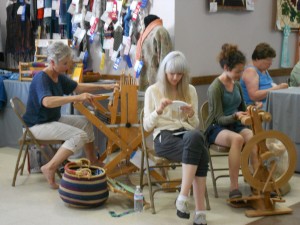
Weaving, knitting and spinning at the Sonoma County Fair
People need to know where their clothes come from and the names of the tools that produce them. It is delightful to explain to children and adults where an animal, plant or synthetic fiber comes from, how it is processed, and what tools are used for turning fiber into cloth. For The General Public to see and touch a spinning wheel, a table or floor loom, a drop spindle, to know that a basket can never be made by a machine, and that the raw cotton (that you might have on the table next to you-along with samples of wool, angora and other fibers that people can touch) turns into the (knitted) t-shirt or (woven) jeans they are wearing. For some, after the light bulb comes on, that is “the reward” for everyone involved in the conversation. Others may need to delve deeper. Often, the men want to inspect the spinning wheel or the loom, and discuss how they would rebuild it. Members of The General Public, both young and old, may see that the people demonstrating are no different from themselves. Just the exposure to a demonstration resonates within, and they become drawn into one of the many fiber arts genre available to them. They need help with the first step. They need to know where to go. They need a friend in fiber arts. They need you.
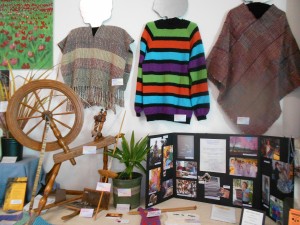
Fiber Arts Booth at the Harvest Festival 10/11
Let’s brainstorm this subject: what is “Outreach”, and what’s the pay-off for you? As an individual, as a fiber arts guild, as a co-operative of artists, or as an individual artist, producer of raw or finished fibers, retailer or wholesaler. Why, when, how and where should you be strutting your stuff-and to whom?
Outreach raises community awareness about fiber arts, brings out the best in community spirit, demonstrates to the public that they, too, can become involved as individuals and ensures that all of these art forms will be continuously available as a cultural contribution to our society.
Although all of us are surrounded by textiles and fibers in our homes and in our closets, an introduction into how to create fiber arts is not readily available in most schools. There are some kits they might encounter at stores like Beverly’s, Michael’s and even Toys R’ Us (remember those pot holder kits!) or raise Silk Worms from a kit and then wonder, ‘what’s next’ and ‘now what do we do?’
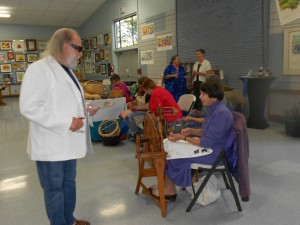
Volunteers demonstrating at the Harvest Fair 10/11
As fiber artists, our role is to be a resource for the community at large. It is important to create a fiber outreach calendar and plan throughout the year. Find two or three public events which will serve as an anchor for your outreach program. Intersperse them with displays at local libraries, bookstore windows and community colleges. Collect from friends and fellow fiber artists an array of raw materials, tools and fiber art creations that can be used in display cases. Although some signage is helpful, as you will see in the photos accompanying this article, a comprehensive display will speak volumes on its own. Create a flyer with websites and local resources such as knitting groups and guild meetings and post them around the community on bulletin boards that will reach children, senior citizens, families and new members to your community. Create websites that can easily be found, with local contacts who can refer an inquiry to the right solution. Connect the knitting groups with the spinners, the people who raise sheep, alpacas and angoras with the rest of the fiber arts village. Don’t leave anyone out. It takes a village.
Our guild has had several successful outreach programs by simply asking – without a complicated plan or proposal. The Santa Rosa Junior College agreed, during a 15 minute phone call, that they would give us the library display cases to feature the life and works of Lydia van Gelder (May 2007); CNCH and the Sonoma Community Center supported our Fun Fleecy Fiber Foray-
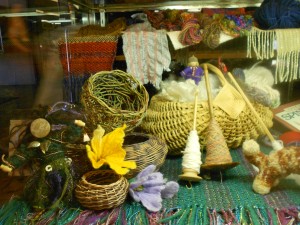
Library Display 2011
(October 2008)—an event created for the public to experience a village of volunteering fiber artists and promoted extensively by the local media. It included display cases with every manner of fiber arts: some created by members of the guild and others donated by local knitting stores. Again, for the asking, members of our guild have installed display cases at 3 different libraries in Sonoma County, had booths at Ag Day (imagine busloads of elementary school kids, some of them, our future fiber artists); the Sonoma County Fair—an annual event where we have fiber artists demonstrating daily for two weeks; and most recently, the Sonoma County
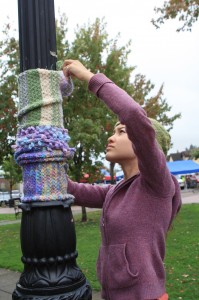
Melody Stein dressing lightpole for iKnit Sebastopol
Harvest Fair, where we had a booth for free, for the asking, and staffed with volunteers demonstrating and promoting fiber arts and local resources to The General Public for three days. Members also participate at various farmers markets and seasonal fairs that focus on holidays and harvests. Locate the person in charge of the event, and offer to provide volunteers to add educational entertainment in the realm of fiber arts.
Other outreach opportunities include demonstrating at elementary schools, girl scout or boy scout troups, 4-H clubs, and community centers. Schools with a inclination towards a Waldorf or Montessori education theory are very receptive to having a volunteer come in for a half day to teach a fiber arts unit. And once your guild has an established reputation for connecting with schools (successful first classes might include “felting”, weaving on small looms made with foam core – use your imagination) you will find that you could easily reach one thousand children in one year (here’s the math: 10 volunteers demonstrate in front of a class of 25 young people, four times per year). Which means, you have actually brought the conversation about fiber arts into one thousand homes and families within your community! How wonderful is that!? And that’s Outreach. Have fun with it! You will have people thanking you for years to come. I promise!
I hope you’ve enjoyed this issue of CNCHnet. Click on February to find out what our next issue will feature